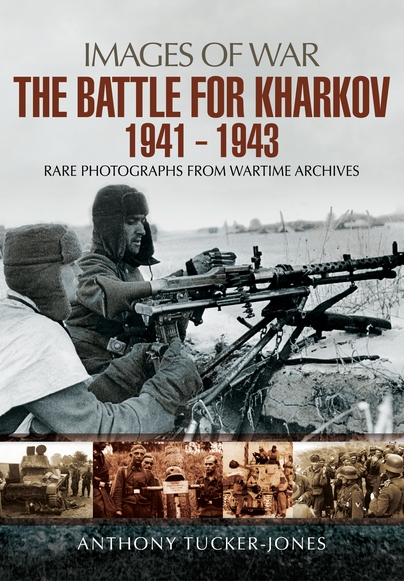| Title: | The Battle for Kharkov |
| Author: | Anthony Tucker-Jones |
| Published by: | Pen & Sword |
| Published in: | 2016 |
| Pages: | 144 |
| ISBN: | 9781473827479 |
| Description: |
During the Second World war the battle at the Eastern front was one of utmost atrocity and an unprecedented amount of men and material. When the Nazi’s invaded Russia in June 1941, they did so with 3,8 million soldiers and thousands of (armoured) vehicles and aircraft. Initially, the Russians could "only" put 3 million men in the field against the Germans. As war progressed, that ratio turned in favour of the Russians and the armies of the Third Reich faced a superior force in numbers. There were different areas at the Russian front with hotspots which were furiously attacked and defended. One of those places was Kharkov. Kharkov was situated at a junction of roads and railways and was seen as the doorstep to the southwest of the Ukraine and the Crimea. In fact, four battles for Kharkov took place: the first in October 1941, the second in May 1942, the third in February 1943 and the final battle in August 1943. The first battle for Kharkov took place at the end of Operation Barbarossa and it was of strategic value for the Germans. The Russians wanted to win time in order to be able to dismantle factories and relocate them to the east. When the Germans captured the city, the factories had already been dismantled and moved beyond the Ural mountains. The second battle for Kharkov was a resounding success for the Germans. The Russians lost nearly 280,000 men (killed or taken prisoner). The best known is the third battle. After the crushing defeat after the battle for Stalingrad, the German high command tried to regain a certain degree of structure in the defence of Russia. However, the Russians didn’t allow their enemy any rest by launching new offensives. Because of those offensives the Germans had to withdraw gradually from all areas on the front. Kharkov was also abandoned. In January 1943 it soon became clear that the Russian troops were becoming exhausted. The German general Erich von Mannstein used that exhaustion to launch an offensive to recapture Kharkov. In the end the Germans lost Kharkov definitely during the fourth battle, which took place after the battle for Kursk, where enormous amounts of material and men were lost. In his book, Tucker-Jones briefly describes the history of the battles. Photographs impressively show the enormity of destruction. It’s terrifying to see and read how hundreds of thousands of soldiers, almost carelessly, were fed into the slaughter by Hitler and Stalin. Tucker-Jones, who already wrote many volumes of the series "Images of War", published by Pen & Sword, has written a decent piece of work again in which he gives a to-the-point description of the bloody battles for Kharkov. Photographs often say more than words and that’s certainly the case with this book. If anyone still would have romantic and heroic notions about war, after having read this book those feeling will surely disappear. |
| Rating: | |
Information
- Translated by:
- Maurice Utermark
- Article by:
- John Smeets
- Published on:
- 20-03-2018
- Last edit on:
- 23-03-2018
- Feedback?
- Send it!




